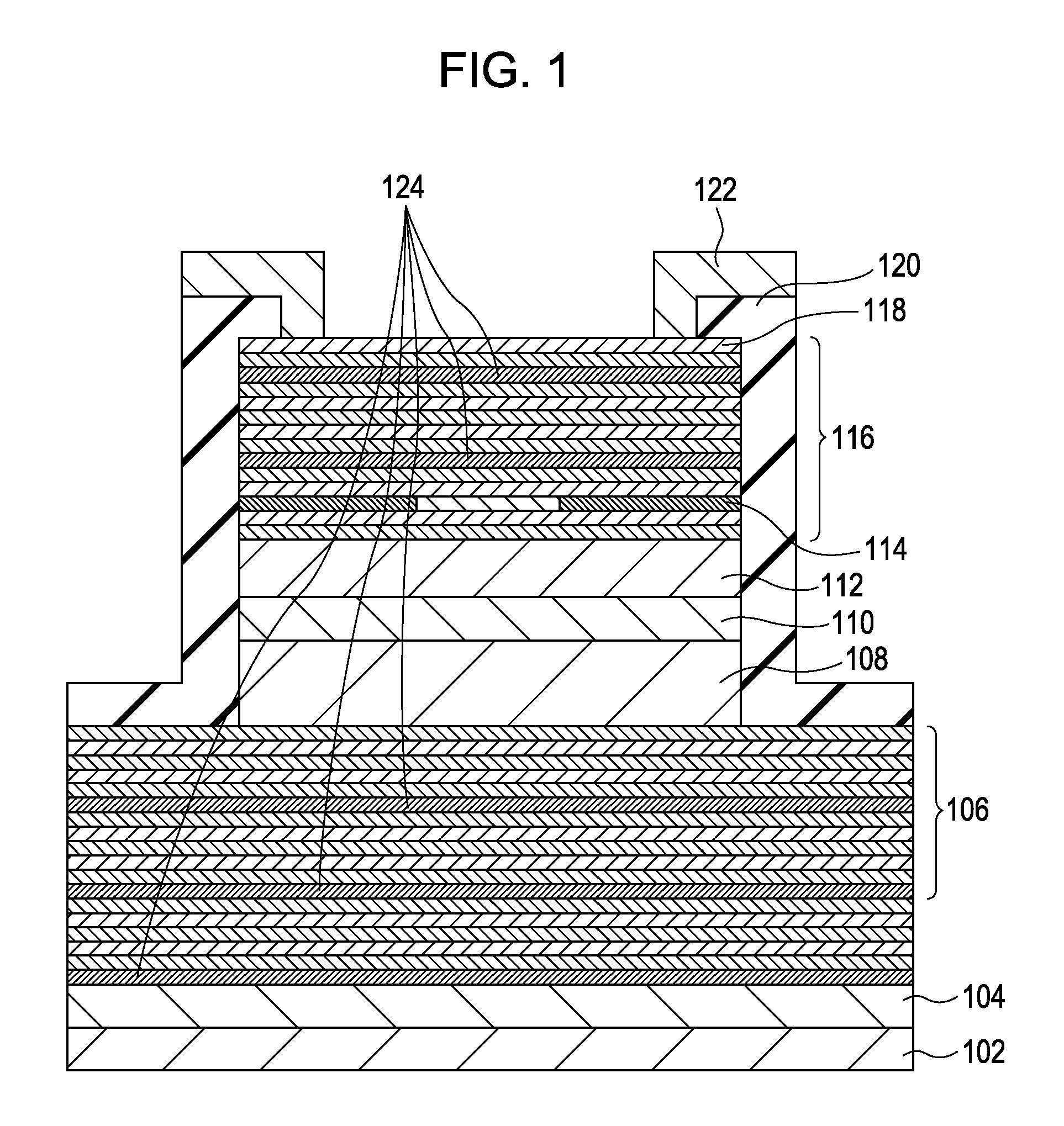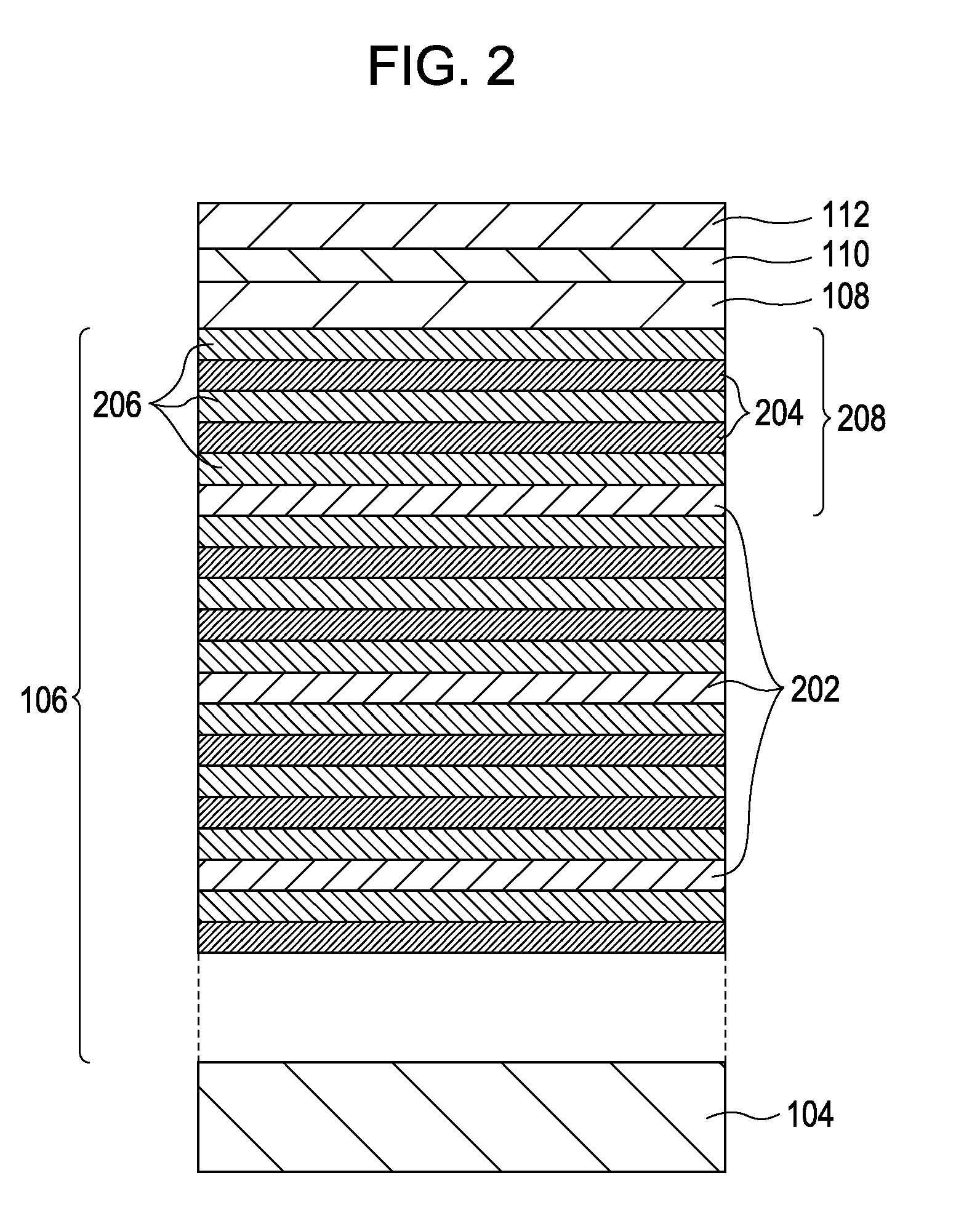Surface emitting laser, surface emitting laser array, and optical apparatus
a laser array and surface technology, applied in the direction of laser optical resonator construction, laser details, semiconductor lasers, etc., can solve the problems of large strain, large difference in refractive index, and limited material content of multilayer film semiconductors, so as to suppress degradation of basic characteristics of elements and prevent heat resistance. , the effect of increasing the heat resistan
- Summary
- Abstract
- Description
- Claims
- Application Information
AI Technical Summary
Benefits of technology
Problems solved by technology
Method used
Image
Examples
example 1
[0119]In Example 1, a configuration example of a vertical cavity surface emitting laser including one pair of multilayer mirrors, which lase at 680 nm and which are disposed opposing to each other, and an active layer disposed between these multilayer mirrors disposed opposing to each other will be described with reference to FIG. 1.
[0120]The surface emitting laser according to the present example is provided with an n-type multilayer mirror 106 including AlGaInP quaternary strain compensation layers 124 and p-type multilayer mirror 116 including the AlGaInP quaternary strain compensation layers 124. In this regard, as shown in FIG. 1, the AlGaInP quaternary strain compensation layers 124 are disposed uniformly on a strain compensation unit structure basis regardless of p-type multilayer mirror or n-type multilayer mirror.
[0121]The manner in which quaternary strain compensation layers are formed is shown in detail by a magnified diagram of the n-type multilayer mirror 106 shown in F...
example 2
[0148]In Example 2, a vertical cavity surface emitting laser including one pair of multilayer mirrors, which lase at 680 nm and which are disposed opposing to each other, and an active layer disposed between these multilayer mirrors disposed opposing to each other will be described with reference to FIG. 5.
[0149]In FIG. 5, the same configurations as those shown in FIG. 1 are indicated by the same reference numerals as those set forth above. Accordingly, further explanations thereof will not be provided, and only different structures will be explained.
[0150]In FIG. 5, reference numeral 502 denotes an n-type AlGaInP strain compensation layer. This layer in itself is the same as the n-type AlGaInP strain compensation layer 124 shown in FIG. 1, but arrangements in the p-type multilayer mirror and the n-type multilayer mirror are different from each other.
[0151]Here, in order to minimize the effect of heat on the GaInP strained quantum well active layer 110, a larger number of quaternary...
example 3
[0174]In Example 3, a vertical cavity surface emitting laser, which lases at 680 nm will be described with reference to FIG. 7. The vertical cavity surface emitting laser of the present example includes one pair of multilayer mirrors disposed opposing to each other and an active layer disposed between the multilayer mirrors.
[0175]In FIG. 7, the same configurations as those shown in FIG. 1 are indicated by the same reference numerals as those set forth above. Accordingly, further explanations thereof will not be provided, and only different structures will be explained. In FIG. 7, reference numeral 702 denotes an n-type AlGaInP strain compensation layer. The strain compensation layer 702 is of the same structure as the n-type AlGaInP strain compensation layer 124 shown in FIG. 1, but the arrangement in the multilayer mirror is different.
[0176]In the present example, in order to minimize the effect of heat on the GaInP strained quantum well active layer 110, a larger number of quatern...
PUM
 Login to View More
Login to View More Abstract
Description
Claims
Application Information
 Login to View More
Login to View More - R&D
- Intellectual Property
- Life Sciences
- Materials
- Tech Scout
- Unparalleled Data Quality
- Higher Quality Content
- 60% Fewer Hallucinations
Browse by: Latest US Patents, China's latest patents, Technical Efficacy Thesaurus, Application Domain, Technology Topic, Popular Technical Reports.
© 2025 PatSnap. All rights reserved.Legal|Privacy policy|Modern Slavery Act Transparency Statement|Sitemap|About US| Contact US: help@patsnap.com



